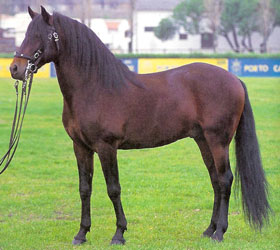
Altér-Real

Introduction: As its name suggests, the Alter-Real breed evolved as a horse fit to be the mount of royalty, presenting its rider in the heroic mold, and being ideally suited in spirit and action for classical school riding. It is a breed of national importance in Portugal. I know very little about the Alter-Real but, as an admirer of the Iberian breeds, I have come to like it very much. I hope to learn more about it and would appreciate any information. I apologize; I cannot find the site where I got this picture. I will get it on here as soon as possible. If you have any comments or suggestions, or recognize this picture and can tell me the site, please click here.
Names: Altér-Real. Real means "royal" in Portuguese, Alter is the province in Portugal with which these horses were bred for most of their history. Sometimes called the Alter for short. (There should be an accent mark over the "e" in Alter, but I probably won't bother trying to get it in all the time at this point!)
Origin: The Alter-Real owes its origins to the three hundred mares selected and imported in 1747 by the House of Braganza, with a view to establishing a national stud at Vila de Portel in the province of Alentejo in southern Portugal, where the breed was founded in 1748. Later in the eighteenth century the Alter-Real was used for the performance of high school exercises in the royal manège, and it was moved to Alter in 1756. The breed was seriously contaminated at the time of the Napoleonic invasion when Arab, English Thoroughbred, Norman, and Hanoverian blood was introduced. However, as a result of the subsequent introduction of Andalusian horses, which was continued into the twentieth century by government intervention, the breed has been reestablished.
Breeding: It started with some 300 of the finest Andalusian mares brought from the area around Jerez de la Frontera, Spain's most famous breeding center. The stud flourished, furnishing horses for the Royal Manège at Lisbon, and the Alter breed became famous for the exhibitions staged there. In the early 19th century, however, much of the stock was lost or stolen when the stud was sacked by Napoleon's troops. In 1834, more disasters overtook Alter, culminating in the abolition of the Royal Stables. A reorganization was attempted under Queen Maria Pia in the late 19th century, and foreign blood was introduced - including English, Norman, Hanoverian, and, most particularly, Arabian. These experiments were unsuccessful and the breed was almost ruined. It was saved by an import of Andalusians. However, the stud archives were largely destroyed after the advent of the Republic in 1910, and it was not until 1932 that constructive efforts were made by the Ministry of Economy to reestablish the breed.
Description: Despite the vicissitudes it has experienced, the modern Alter, virtually Andalusian again, survives as a highly courageous horse of distinct physical character with an extravagant, high, showy action, especially suited to the Haute Ecole. A horse of the meso-dolichomorphic type.
Action: High and animated, with extravagant high knee action.
Body: Short and compact with broad, deep chest, short back, deep girth, strong loins, muscular, rounded croup and powerful, rounded hindquarters.
Color: Bay, brown, chestnut, and gray. Piebald was mentioned in one book but I have found no evidence for part-colored Alter-Reals anywhere else. Bay seems to be the predominant color.
Eyes: Expressive.
Head: Noble, small to medium-sized head, with straight or slightly convex profile and large wide-set eyes. Of average proportions, with pronounced jaws and full forelock.
Hooves: Well-formed.
Legs: Fine with good, fine, hard bone. Solid and well-muscled, the thigh muscular, the cannons slender but sturdy, the tendons clean and strong.
Neck: Quite short, muscular, arched, and crested, with thick, luxuriant, silky, flowing mane.
Pasterns: Long and moderately sloped. Slender but sturdy.
Profile: Straight or, more often, slightly convex.
Shoulders: Strong and very sloped. Muscular and nicely sloping.
Size: Stands between 15 and 16 hands high. One source says 15.1 to 16.1 hands (1.52 to 1.62 meters).
Tail: Well set-on, long, full, thick, and luxuriant.
Withers: Pronounced.
Temperament: They are said to be intelligent, quick to learn, highly-strung, and brave. Quiet, but highly courageous.
Features: The Alter-Real's high action, so typical of the classical school horse, seems to be its most well-known and noticeable feature.
Uses: Riding, especially high school equitation.
Accomplishments: I don't know of any extraordinary accomplishments by the Alter-Real except of course its aptitude for high school equitation and the Haute Ecole, which I consider to be no mean achievement! Also, an Alter stallion, sent to Brazil more than a hundred years ago, founded the Mangalarga breed.
Curiosities: Only that this breed was able to come back from near ruin to be what it is today - a fine example of Iberian equine artwork at its best!
Profiles: I don't know of any very important horses in this breed.
Conclusion: The Alter-Real is a beautiful horse, and I am so glad that it was not ruined or lost in all that it has been through. I must confess, I prefer Spanish- and Barb-type horses over Thoroughbred- and Arab-type and this is one breed I have used in showing my (very patient!) friends and family that the Arab-type influence is not always the best for the situation. I hope that I can find more about the Alter-Real and maybe even get a chance to see one!